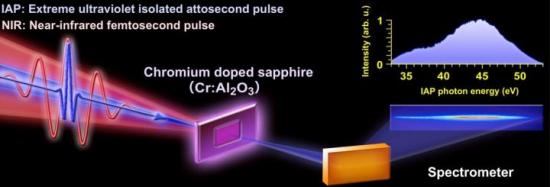Attosecond Light Source Measures Ultrafast Electron Oscillation and Dephasing

A NIR femtosecond pulse (pump pulse) induces electron oscillation, which is monitored by an extreme ultraviolet (EUV) IAP (probe pulse) based on transient absorption spectroscopy. (Credit: Nippon Telegraph and Telephone)
Attosecond light pulses have enabled Japanese researchers at Yokohama National University (YNU) and Nippon Telegraph and Telephone (NTT) to observe petahertz (1015 Hz) rate oscillations of electrons. The resulting periodic oscillations of 667-383 attoseconds is the fastest that has ever been measured using direct time-dependent spectroscopy in solid-state material.
Researchers generally use ultrafast light pulses to observe the ultrafast motion of an electron underlying a physical phenomenon. The shorter the pulse duration, the faster the electron oscillation that can be observed. The lightwave-field frequency of high-harmonic generation of light in the visible and UV region can reach the petahertz (PHz: 1015 Hz) region, which means that the oscillation periodicity can achieve attosecond (10-18 of a second) duration.
RELATED: Attosecond photonic technique reveals time of electron emission from atom
In previous studies, NTT researchers in the team generated an isolated attosecond pulse (IAP) [H. Mashiko et al., Nature Commun. 5, 5599 (2014)] and monitored the electron oscillation with 1.2-PHz frequency within a gallium nitride (GaN) semiconductor [H. Mashiko et al., Nature Phys. 5, 741 (2016)]. The next challenges will be to observe faster electron oscillation in a chromium doped sapphire (Cr:Al2O3) insulator and to characterize ultrafast electron dephasing.
The paper, published in the journal Nature communications reports a successful observation of near-infrared (NIR) pulse-induced multiple electronic dipole oscillations (periodicities of 667-383 as) in the Cr:Al2O3 solid-state material. The measurement is realized by the extreme short IAP (192 attosecond duration) and the use of stable pump (NIR pulse) and probe (IAP) system (timing jitter of ~23 attoseconds). The characterized electron oscillations are the fastest that have ever been measured using direct time-dependent spectroscopy.
The research results will aid in developing future electronic and photonic devices, says Hiroki Mashiko, a NTT scientist on the team.
(From: https://www.eurekalert.org/pub_releases/2018-04/ynu-ueo041818.php)
